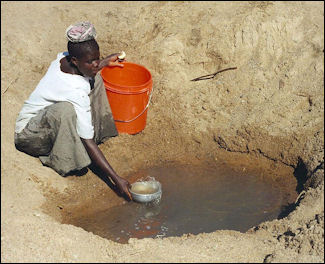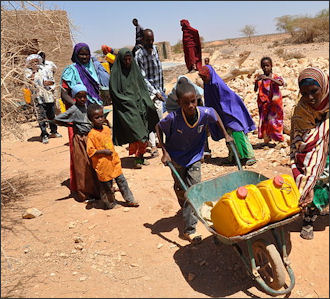WATER SHORTAGES

The World Meteorological Organization regards drinking water shortages as among the primary obstacles to sustainable development. Currently one third of humanity experiences permanent water shortages. Two thirds may experience the problem if population and global warming trends continue.
Water shortages are a global problem and are particularly serious in arid regions. Causes of water shortages include swelling population, depletion of groundwater, wasteful irrigation, waste, pollution and global warming. In many places agriculture relies too much on ground water for irrigation. In urban areas many people illegally tap into water supplies without paying for it. In places where there is ample water is wasted in leaky pipes and other substandard infrastructure. Fixing leak pipes is an expensive, time-consuming endeavor that can take decades to complete.
Reports: “The U.N. World Water Development Report 2009 “ by UNESCO;”India’s Water Economy: Bracing for a Turbulent Future “ and “Pakistan’s Water Economy: Running Worry “ by the World Bank; and “Asia’s Next Challenge: Securing the Region’s water Future “.
See Separate Article WATER SHORTAGES IN CHINA factsanddetails.com
Consequence of Water Shortages
The consequence of water shortages include drought and famine, loss of livelihoods, the spread of water-borne disease, forced migrations and even conflicts.
Poverty expert Jeffrey Sachs of the Earth Institute of Columbia University wrote: “many conflicts are caused or inflamed by water scarcity. The conflicts from Chad to Darfur, Sudan to the Ogaden desert of Ethiopia to Somalia and it pirates and across to Yemen, Iraq, Pakistan and Afghanistan, lie in a great arc of arid lands, where water scarcity is leading to failed crops, dying livestock extreme poverty, and desperation.”
“Extremist groups like the Taliban find ample recruitment possibilities in such impoverished communities. Governments lose their legitimacy, when they cannot guarantee their populations’ most basic needs: safe drinking water, staple food crops, and fodder and water for animal herds on which communities depend for their meager livelihoods....Politicians, diplomats and generals in conflict-ridden countries typically treat these crises as they would any other political or military challenge. They mobilize armies, organize political factions, combat warlords.”
The United States and Europe often spend ten or even hundreds of billions of dollars to send troops or bombers to quell uprisings or target “failed states,” but do not send one-tenth to one-hundredths that amount to address the underlying crises of water scarcity and underdevelopment.
Solutions to Water Shortages

Somalia Drought
Among the solutions to water scarcity are better water management, improved technologies to increase efficiency, higher prices for water to decease waste, conservation, investments by governments, the private sector and communities in basic water infrastructure, and cooperation among communities sharing water sources.
Sachs wrote: “Most governments are poorly equipped to deal with serious water challenges. Water ministries are typically staffed with engineers and generalist civil servants yet lasting solutions to water challenges require a broad range of expert knowledge about climate, ecology, farming, population, engineering , economics, community, politics, and local cultures. Government officials also need the skill and flexibility to work with local governments, private businesses, international organizations, and potential donors.
The World Bank, International Monetary Fund, Asian Development Bank are all involved in funding water projects around the globe. Private companies are also involved. In Senegal, the world’s leading pipe maker JM Eagle donated 100 kilometers of piping that is used to bring water to tens of thousands of people.
Water Pricing and Waste-Water Recycling
Pricing water to make it more dear is increasingly being seen as the primary solution to the world’s water problems. When water prices were significantly raised in the United States in the 1960s and the money was used to improve irrigation, push low-capacity toilets and build water treatment facilities and the like, per capita water consumption fell by more than a quarter. In the developing world, however, it is hard to take similar measures because people are simply too poor to absorb any increase in water prices.
In the developed world where water shortages are acute, governments are increasingly looking into waste-water-recycling plants that can recycle sewage into a drinking water. One such plant in Orange County, California cost $480 million to build and requires $29 million annually to run. At this facility dark brown sludge that enters the system first goes through vertical tubes filled with polypropylene tubes that thickness of dental floss that are filled with holes 1/300th the size of a human hair that filters out many bacteria and protozoa as well as nasty “suspended solids.” Every 20 minutes are so there is a backwash or water and air blasts the tubes clean.
After that the water is pumped into the reverse osmosis chambers where it is mixed with sulfuric acid to lower the pH and pushed though several sheets of plastic membranes that removes salts, viruses and pharmaceuticals. After this hydrogen peroxide, a disinfectant, is added to the water which is then zapped with ultraviolet light, and decarbonized. For a final step lime is added to raise the pH. The result: clean water.
Water-Extracting Methods and Low-Tech Water Technology

Low-tech technologies used to collect water in arid regions include: 1) fine mesh “fog catching” nets stretched between poles that collect usable water from fog; 2) “rooftop harvesting” using pipes that divert rain from rooftops into a cistern; and 3) desalination cones placed in saltwater. With the latter sun evaporates water, which condenses on the cones inner wall and trickles down into collection areas around the bottom edges.
Among the low-tech water technology used to provide water and make it safe are: 1) filtration straws that trap disease-causing bacteria allowing people to safely drink untreated water (already over two million especially use such straws, which cost about $3 each, See LifeStraw,); 2) folding fine-weave clothing like an old sari four times to filter out pathogens like the cholera-causing bacteria; and 3) bamboo treadle pumps made up of inexpensive local materials that help farmers tap ground water to irrigate small plots of land.
Iceberg Catching and High-Tech Water Technology
Scientists are beginning to seriously study things like transporting icebergs as a way to alleviate global water shortages. Icebergs that have reached a size of 160 kilometers long, 70 kilometers long and 250 meters thick have been observed. A large iceberg can take eight to 12 years to melt completely. Winds and currents often carry them 40 to 50 degrees south latitude.
Technology currently exists to “catch small icebergs up to 0.1 cubic kilometers in size, and tow them to the African coast with powerful tugboats, The biggest obstacle to overcome is wrapping the iceberg in a protective film to keep the ice from thawing en route. Another idea is breaking up the icebergs where they are found and loading the broken ice into tankers.
Others are exploring weather modification. A wind powered spray turbine mounted on an anchored platform in the ocean sucks in ocean water through pipes then filters and sprays fine droplets into the sky. The humidified water produces clouds and rain.
See China
Obstacles to Combating Water Shortages
One of the main obstacles to combating water shortages is that government prefer to spend money on other things. Peter Rogers, a Harvard environmental engineering professor, told U.S. News and World Report: governments and the private sector “want to invest in energy, telecoms, highways, high-speed trains, you name it...the problem is [water] yields social benefits, so no one individual can afford to do it.”
Money is on water is drying up. In the late 1990s, public spending on water and sanitation was 2 percent of the GDP of most countries, By the late 2000s it had dwindled to less than 1 percent as countries devoted more money to education, roads and other needs. Foreign assistance for water-related issues has stagnated at about $15 billion a year. The World Bank has said a minimum of twice that amount is needed. The United States spent about $1.7 billion on water-related aid from 2003 and 2005, with a good chunk of that going to Iraq and Afghanistan.
One paradox with water is that efficiency can make matter worse on an economic level. The more water that is conserved the less money is earned by utility company that use their revenues to improve water infrastructure. Some policy makers say the solution to this is to creating a public fund for water like the one that finances highway construction with a tax on gas.
Desert Agriculture Innovations
Some have recommended that farms install more rain saving devices and reduce waste on irrigation by finding leaky pipes, replacing water ditches with pressurized taps, and using trickle-down agriculture that deliver small, steady amounts of water directly to the roots of plants.
Low-tech hydroponic schemes pioneered by Brazilian engineer Jose Roberto Fonseca include: 1) sprouting plants in water laced with nutrients held in plastic Coca-Cola bottles feed with ultra thin tubes; 2) using seawater desalinated with a solar-powered desalinator; 3) catching water from a well on a hillock and using gravity to deliver it to gardens below; 4) storing water in underground cisterns; 5) pumping water with solar-powered pumps; and 6) using recycling systems that avoid evaporation and reduces waste.
So-called resurrection plants — grassy plants such as “Xerophyra viscosa “ found in the Drakenburg range in South Africa that can survive long periods without water and burst to life when it rains — are being mined for genetic material that can be inserted into corn and other crops that can help them grow in dry climates, with little or salty water and few fertilizer. “Xerophyra viscosa “ is being studied because it can grow on rocks at high altitudes, in thin souls in a variety conditions and very little water.
See Separate Article DESERT AGRICULTURE AND IRRIGATION factsanddetails.com
Image Sources:
Text Sources: World Almanac, United States Geological Survey (USGS) Minerals Resources Program, Investopedia Industry Handbooks, U.S. Energy Information Administration, Department of Energy National Geographic articles. Also the New York Times, Washington Post, Los Angeles Times, Smithsonian magazine, Natural History magazine, Discover magazine, Times of London, The New Yorker, Time, Newsweek, Reuters, AP, AFP, Lonely Planet Guides, Compton’s Encyclopedia and various books and other publications.
Last updated March 2022
